标签:文件处理 直接 tst pac trunc while 并发 har 有助于
Java NIO是从Java1.4版本开始引入的一个新的IO的API,可以替代标准的Java的IO的API。NIO和原来的IO有同样的作用和目的,但是使用的方式完全不同,NIO支持面向缓冲区的、给予通道的IO操作。NIO将以更加高效的方式进行文件的读写操作。
| IO | NIO |
|---|---|
| 面向流(Stream Oriented) | 面向缓冲区(Buffer Oriented) |
| 阻塞IO(Blocking IO) | 非阻塞IO(Non Blocking IO) |
| 无 | 选择器(Selectors) |
Java NIO系统的核心在于:通道(Channel)和缓冲区(Buffer)。通道表示打开到IO设备(例如:文件、Socket)的连接。如果需要使用NIO系统,需要获取用于连接IO设备的通道以及用于容纳数据的缓冲区,然后操作缓冲区,对数据进行处理。
public static XxxBuffer allocate(int capacity) {}
容量(capacity):表示Buffer最大数据容量,缓冲区容量不能为负,并且一旦创建不能更改。
限制(limit):第一个不应该读取或写入的数据的索引,即位于limit后的数据不可读写。缓冲区的限制不能为负,并且不能大于容量。
位置(position):下一个要读取或写入的数据的索引。缓冲区的位置不能为负,并且不能大于其限制。
标记(mark)和重置(reset):标记是一个索引,通过Buffer中的mark()方法指定Buffer中的一个特定的position,之后可以通过调用reset()方法恢复到这个position。
简而言之:0 <= mark <= position <= limit <= capacity。
| 方法 | 说明 |
|---|---|
| Buffer clear() | 清空缓冲区并返回对缓冲区的引用 |
| Buffer flip() | 将缓冲区的界限设置为当前位置,并将当前位置设置为0。切换到读数据模式。 |
| int Capacity() | 返回Buffer的capacity大小 |
| boolean hasRemaining() | 判断缓冲区中是否还有元素 |
| int limit() | 返回Buffer的界限(limit)的位置 |
| Buffer limit(int n) | 设置缓冲区界限为n,并返回一个具有新limit的缓冲区对象 |
| Buffer mark() | 对缓冲区进行标记 |
| int position() | 返回缓冲区的当前位置position |
| Buffer position(int n) | 将设置缓冲区的当前位置为n,并返回修改后的Buffer对象 |
| int remaining() | 返回position和limit之间的元素个数 |
| Buffer reset() | 将位置position为以前设置的mark所在的位置 |
| Buffer rewind() | 将位置position设置为0,取消设置的mark |
package com.weiwei.xu;
import org.junit.Test;
import java.nio.ByteBuffer;
/**
* 一、缓冲区(Buffer):在Java NIO中负责数据的存取。缓冲区就是数组。数组是用于存储相同数据类型的数据。
* 根据数据类型的不同,提供了相应类型的缓冲区(boolean除外):ByteBuffer、CharBuffer、ShortBuffer、IntBuffer、LongBuffer、FloatBuffer、DoubleBuffer。
* 上述缓冲区的管理方式几乎一致,都是通过allocate()获取缓冲区。
*
* 二、缓冲区存取数据的两个核心方法:
* put():存入数据到缓冲区。
* get():、。
*
* 三、缓冲区中的四个核心属性。
* capacity:容量,表示缓冲区中最大存储数据的容量。一旦声明,不能更改。
* limit:限制,界限,表示缓冲区可以操作数据的大小。(limit后面的数据不能进行读写)。
* position:位置,表示缓冲区中正在操作数据的位置。
* mark:标记,表示记录当前position的位置,可以通过reset()恢复到mark的位置。
*
* 0 <= mark <= position <= limit <= capacity
*/
public class BufferTest {
@Test
public void test1() {
//分配一个指定大小的缓冲区
ByteBuffer buffer = ByteBuffer.allocate(1024);
System.out.println("----------------allocate--------------");
System.out.println("position:" + buffer.position());//0
System.out.println("limit:" + buffer.limit());//1024
System.out.println("capacity:" + buffer.capacity());//1024
//利用put()方法存入数据到缓冲区中
String str = "abcde";
buffer.put(str.getBytes());
System.out.println("----------------put--------------");
System.out.println("position:" + buffer.position());//5
System.out.println("limit:" + buffer.limit());//1024
System.out.println("capacity:" + buffer.capacity());//1024
//切换到读数据模式
buffer.flip();
System.out.println("----------------flip--------------");
System.out.println("position:" + buffer.position());//0
System.out.println("limit:" + buffer.limit());//5
System.out.println("capacity:" + buffer.capacity());//1024
//利用get()方法读取数据
byte[] dst = new byte[buffer.limit()];
buffer.get(dst);
System.out.println("获取缓冲区中的数据:" + new String(dst, 0, dst.length));
System.out.println("----------------get--------------");
System.out.println("position:" + buffer.position());//5
System.out.println("limit:" + buffer.limit());//5
System.out.println("capacity:" + buffer.capacity());//1024
//重复读数据,将位置position设置为0
buffer.rewind();
System.out.println("----------------rewind--------------");
System.out.println("position:" + buffer.position());//0
System.out.println("limit:" + buffer.limit());//5
System.out.println("capacity:" + buffer.capacity());//1024
//清空缓冲区,但是缓冲区的数据依然存在,数据处于“被遗忘状态”。
buffer.clear();
System.out.println("----------------clear--------------");
System.out.println("position:" + buffer.position());//0
System.out.println("limit:" + buffer.limit());//1024
System.out.println("capacity:" + buffer.capacity());//1024
}
@Test
public void test2() {
ByteBuffer buffer = ByteBuffer.allocate(1024);
String str = "abcde";
buffer.put(str.getBytes());
buffer.flip();
byte[] dst = new byte[buffer.limit()];
buffer.get(dst,0,2);
System.out.println(new String(dst,0,2));
System.out.println("position:"+buffer.position());//2
buffer.mark();
buffer.get(dst,2,2);
System.out.println(new String(dst,2,2));
System.out.println("position:"+buffer.position());//4
buffer.reset();
System.out.println("position:"+buffer.position());//2
//判断缓冲区中是否含有剩余数据
if(buffer.hasRemaining()){
System.out.println("获取缓冲区中可以操作的数量"+buffer.remaining());
}
}
}
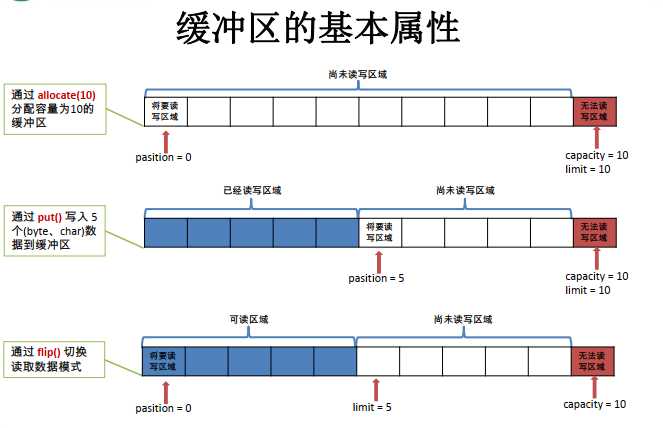
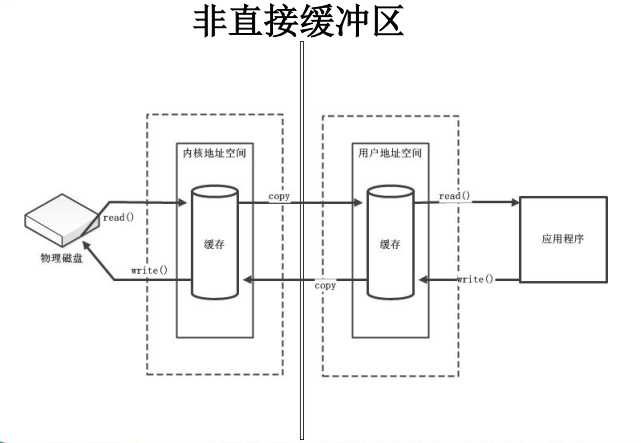
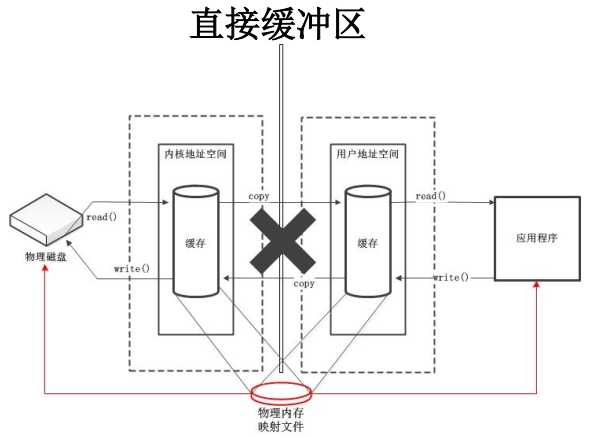
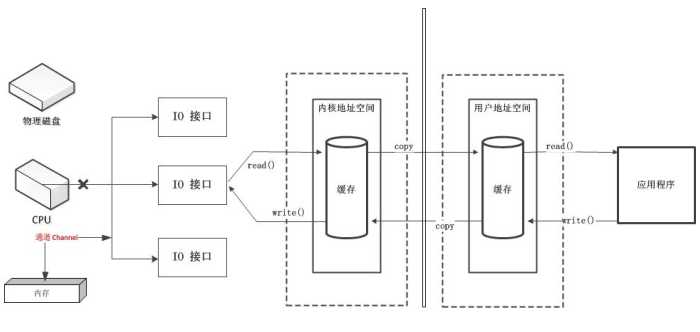
package com.weiwei.xu;
import org.junit.Test;
import java.io.FileInputStream;
import java.io.FileOutputStream;
import java.io.IOException;
import java.nio.ByteBuffer;
import java.nio.MappedByteBuffer;
import java.nio.channels.FileChannel;
import java.nio.file.Paths;
import java.nio.file.StandardOpenOption;
/**
* 一、通道(Channel):用于源节点和目标节点之间的连接。在Java NIO中负责缓冲区中数据的传输。Channel本身是不存储数据,因此需要配合缓冲区进行操作。
* 二、通道的主要实现类
* java.nio.channels.Channel接口
* |--FileChannel
* |--SocketChannel
* |--ServerSocketChannel
* |--DatagramChannel
* 三、获取通道
* ①Java支持通道的类提供了getChannel()方法。
* 本地IO:FileInputStream、FileOutputStream、RandomAccessFile
* 网络IO:Socket、ServerSocket、DatagramSocket
* ②在JDK1.7中的NIO2针对各个通道提供了静态方法open()。
* ③在JDK1.7中的NIO2的Files工具类的newByteChannel()。
* 四、通道之间的数据传输
* transferFrom()
* transferTo()
*/
public class ChannelTest {
/**
* 利用直接缓冲区完成文件的复制
*
* @throws IOException
*/
@Test
public void test3() throws IOException {
FileChannel inFileChannel = FileChannel.open(Paths.get("D:\\project\\nio\\1.jpg"), StandardOpenOption.READ);
FileChannel outFileChannel = FileChannel.open(Paths.get("D:\\project\\nio\\2.jpg"), StandardOpenOption.READ, StandardOpenOption.WRITE, StandardOpenOption.CREATE);
inFileChannel.transferTo(0, inFileChannel.size(), outFileChannel);
outFileChannel.close();
inFileChannel.close();
}
/**
* 利用直接缓冲区完成文件的复制(内存映射文件)
*/
@Test
public void test2() throws IOException {
FileChannel inFileChannel = FileChannel.open(Paths.get("D:\\project\\nio\\1.jpg"), StandardOpenOption.READ);
FileChannel outFileChannel = FileChannel.open(Paths.get("D:\\project\\nio\\2.jpg"), StandardOpenOption.READ, StandardOpenOption.WRITE, StandardOpenOption.CREATE);
//内存映射文件
MappedByteBuffer inMappedByteBuffer = inFileChannel.map(FileChannel.MapMode.READ_ONLY, 0, inFileChannel.size());
MappedByteBuffer outMappedByteBuffer = outFileChannel.map(FileChannel.MapMode.READ_WRITE, 0, inFileChannel.size());
//直接对缓冲区进行数据的读写操作
byte[] dst = new byte[inMappedByteBuffer.limit()];
inMappedByteBuffer.get(dst);
outMappedByteBuffer.put(dst);
inFileChannel.close();
outFileChannel.close();
}
/**
* 利用通道完成文件的复制(非直接缓冲区)
*
* @throws IOException
*/
@Test
public void test() throws IOException {
FileInputStream fileInputStream = new FileInputStream("D:\\project\\nio\\1.jpg");
FileOutputStream fileOutputStream = new FileOutputStream("D:\\project\\nio\\2.jpg");
//①获取通道
FileChannel fileInputStreamChannel = fileInputStream.getChannel();
FileChannel fileOutputStreamChannel = fileOutputStream.getChannel();
//②分配指定大小的缓冲区
ByteBuffer buffer = ByteBuffer.allocate(1024);
//③将通道中的数据存入缓冲区
while (-1 != fileInputStreamChannel.read(buffer)) {
buffer.flip();
//④将缓冲区的数据写入通道
fileOutputStreamChannel.write(buffer);
//清空缓冲区
buffer.clear();
}
fileOutputStreamChannel.close();
fileInputStreamChannel.close();
fileOutputStream.close();
fileInputStream.close();
}
}
| 方法 | 描述 |
|---|---|
| int read(ByteBuffer dst) | 从Channel中读取数据到ByteBuffer |
| long read(ByteBuffer[] dsts) | 将Channel中的数据“分散”到ByteBuffer[] |
| int write(ByteBuffer src) | 将ByteBuffer中的数据写入到Channel |
| long write(ByteBuffer[] srcs) | 将ByteBuffer[]中的数据“聚集”到Channel |
| long position() | 返回此通道的文件位置 |
| FileChannel position(long p) | 设置此通道的文件位置 |
| long size() | 返回此通道的文件的当前大小 |
| FileChannel truncate(long s) | 将此通道的文件截取到给定大小 |
| void force(boolean metaData) | 强制将所有对此通道的文件更新写入到存储设备中 |
/**
* 利用通道完成文件的复制(非直接缓冲区)
*
* @throws IOException
*/
@Test
public void test() throws IOException {
FileInputStream fileInputStream = new FileInputStream("D:\\project\\nio\\1.jpg");
FileOutputStream fileOutputStream = new FileOutputStream("D:\\project\\nio\\2.jpg");
//①获取通道
FileChannel fileInputStreamChannel = fileInputStream.getChannel();
FileChannel fileOutputStreamChannel = fileOutputStream.getChannel();
//②分配指定大小的缓冲区
ByteBuffer buffer = ByteBuffer.allocate(1024);
//③将通道中的数据存入缓冲区
while (-1 != fileInputStreamChannel.read(buffer)) {
buffer.flip();
//④将缓冲区的数据写入通道
fileOutputStreamChannel.write(buffer);
buffer.clear();
}
fileOutputStreamChannel.close();
fileInputStreamChannel.close();
fileOutputStream.close();
fileInputStream.close();
}
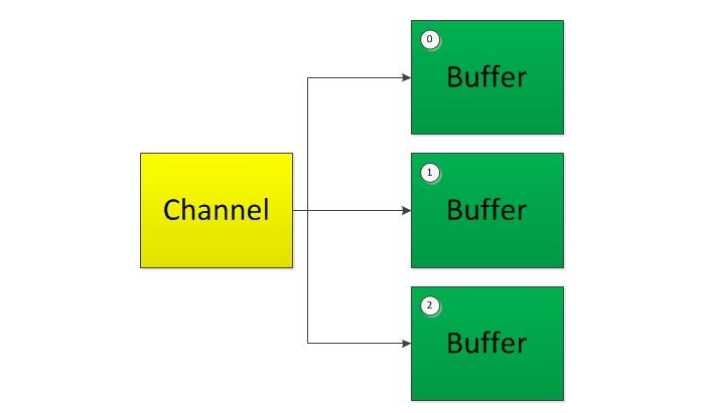
注意:按照缓冲区的顺序,从Channel中读取的数据依次将Buffer填满。

注意:按照缓冲区的顺序,写入position和limit之间的数据到Channel。
package com.weiwei.xu;
import org.junit.Test;
import java.io.FileInputStream;
import java.io.FileOutputStream;
import java.io.IOException;
import java.nio.ByteBuffer;
import java.nio.channels.FileChannel;
public class ChannelTest {
@Test
public void test() throws IOException {
FileInputStream fileInputStream = new FileInputStream("D:\\project\\nio\\1.jpg");
FileOutputStream fileOutputStream = new FileOutputStream("D:\\project\\nio\\2.jpg");
FileChannel fileInputStreamChannel = fileInputStream.getChannel();
FileChannel fileOutputStreamChannel = fileOutputStream.getChannel();
ByteBuffer buffer1 = ByteBuffer.allocate(512);
ByteBuffer buffer2 = ByteBuffer.allocate(512);
ByteBuffer[] buffers = new ByteBuffer[]{buffer1, buffer2};
while (-1 != fileInputStreamChannel.read(buffers)) {
for (ByteBuffer buffer : buffers) {
buffer.flip();
}
fileOutputStreamChannel.write(buffers);
for (ByteBuffer buffer : buffers) {
buffer.clear();
}
}
fileInputStreamChannel.close();
fileOutputStreamChannel.close();
}
}

当调用register(Selector sel,int ops)将通道注册选择器的时候,选择器对通道的监听事件,需要通过第二个参数ops来指定。
可以监听的事件类型(可以使用SelectionKey的四个常量来表示):
如果注册的时候不止监听一个事件,可以使用"|"操作符连接。
int interestSet = SelectionKey.OP_READ | SelectionKey.OP_WRITE;
| 方法 | 描述 |
|---|---|
| Set |
返回所有的SelectionKey集合。代表注册在该Selector上的Channel |
| Set |
返回此Selector的已选择键 |
| int select() | 监控所有注册的Channel,如果有需要处理的IO操作的时候,将对应的SelectionKey加入已选择的SelectionKey集合集合中,并返回这些Channel的数量。 |
| int select(long timeout) | 可以设置超时时长的select()操作 |
| int selectNow() | 执行一个立即返回的select()操作,该方法不会阻塞线程 |
| Selector wakeup() | 使得一个还未返回的select()方法立即返回 |
| void close() | 关闭该选择器 |
| 方法 | 描述 |
|---|---|
| int interestOps() | 获取感兴趣的事件集合 |
| int readyOps() | 获取通道已经准备就绪的操作的集合 |
| SelectableChannel channel() | 获取注册通道 |
| Selector selector() | 返回选择器 |
| boolean isReadable() | 检测Channel中读事件是否就绪 |
| boolean isWriteable() | 检测Channel中写事件是否就绪 |
| boolean isConnectable() | 检测Channel中连接是否就绪 |
| boolean isAcceptable() | 检测Channel中接受是否就绪 |
package com.weiwei.xu;
import org.junit.Test;
import java.io.IOException;
import java.net.InetSocketAddress;
import java.nio.ByteBuffer;
import java.nio.channels.FileChannel;
import java.nio.channels.ServerSocketChannel;
import java.nio.channels.SocketChannel;
import java.nio.file.Paths;
import java.nio.file.StandardOpenOption;
/**
* 一、使用NIO完成网络通信的三个核心:
* ①通道(Channel):负责连接。
* java.nio.channels.Channel接口:
* |--SelectableChannel
* |--SocketChannel
* |--ServerSocketChannel
* |--DatagramChannel
*
* |--Pipe.SinkChannel
* |--Pipe.SourceChannel
* ②缓冲区(Buffer):负责数据的存取。
* ③选择器(Selector):是SelectableChannel的多路复用器。用于监控SelectableChannel的一些IO状况。
*/
public class BlockingNIOTest {
@Test
public void client() throws IOException {
//获取通道
SocketChannel socketChannel = SocketChannel.open(new InetSocketAddress(9898));
FileChannel fileChannel = FileChannel.open(Paths.get("1.jpg"), StandardOpenOption.READ);
//分配指定大小的缓冲区
ByteBuffer buffer = ByteBuffer.allocate(1024);
//读取本地文件,并发送到服务器端
while (-1 != fileChannel.read(buffer)) {
buffer.flip();
socketChannel.write(buffer);
buffer.clear();
}
//通知服务器端传送完毕
socketChannel.shutdownOutput();
int len = 0;
while ((len = socketChannel.read(buffer)) != -1) {
buffer.flip();
System.out.println(new String(buffer.array(),0,len));
buffer.clear();
}
fileChannel.close();
socketChannel.close();
}
@Test
public void server() throws IOException {
//获取通道
ServerSocketChannel serverSocketChannel = ServerSocketChannel.open();
//绑定端口号
serverSocketChannel.bind(new InetSocketAddress(9898));
SocketChannel socketChannel = serverSocketChannel.accept();
FileChannel fileChannel = FileChannel.open(Paths.get("2.jpg"), StandardOpenOption.READ, StandardOpenOption.WRITE, StandardOpenOption.CREATE);
//分配指定大小的缓冲区
ByteBuffer buffer = ByteBuffer.allocate(1024);
while (-1 != socketChannel.read(buffer)) {
buffer.flip();
fileChannel.write(buffer);
buffer.clear();
}
buffer.put("服务器端接受成功".getBytes());
buffer.flip();
socketChannel.write(buffer);
fileChannel.close();
socketChannel.close();
}
}
package com.weiwei.xu;
import org.junit.Test;
import java.io.IOException;
import java.net.InetSocketAddress;
import java.nio.ByteBuffer;
import java.nio.channels.SelectionKey;
import java.nio.channels.Selector;
import java.nio.channels.ServerSocketChannel;
import java.nio.channels.SocketChannel;
import java.util.Date;
import java.util.Iterator;
public class NOBlockingNIOTest {
@Test
public void client() throws IOException {
//获取通道
SocketChannel socketChannel = SocketChannel.open(new InetSocketAddress(9897));
//切换成非阻塞模式
socketChannel.configureBlocking(false);
//分配指定大小的缓冲区
ByteBuffer buffer = ByteBuffer.allocate(1024);
//发送数据给服务器端
buffer.put(new Date().toString().getBytes());
buffer.flip();
socketChannel.write(buffer);
//关闭通道
socketChannel.close();
}
@Test
public void server() throws IOException {
//获取通道
ServerSocketChannel serverSocketChannel = ServerSocketChannel.open();
//切换成非阻塞模式
serverSocketChannel.configureBlocking(false);
//绑定端口
serverSocketChannel.bind(new InetSocketAddress(9897));
//获取选择器
Selector selector = Selector.open();
//将通道注册到选择器上,并且指定监听事件
serverSocketChannel.register(selector, SelectionKey.OP_ACCEPT);
//轮询式的获取选择器上已经“准备就绪”的事件
while (selector.select() > 0) {
//获取当前选择器中所有注册的“选择键(已注册的监听事件)”
Iterator<SelectionKey> iterator = selector.selectedKeys().iterator();
//遍历
while (iterator.hasNext()) {
SelectionKey selectionKey = iterator.next();
//判断具体是什么事件准备就绪
if (selectionKey.isAcceptable()) {
//如果是“接受就绪”,获取客户端的连接
SocketChannel socketChannel = serverSocketChannel.accept();
//切换成非阻塞模式
socketChannel.configureBlocking(false);
//将该通道注册到选择器上
socketChannel.register(selector, SelectionKey.OP_READ);
} else if (selectionKey.isReadable()) {
//获取当前选择器上“读就绪”状态的通道
SocketChannel socketChannel = (SocketChannel) selectionKey.channel();
//读取数据
ByteBuffer buffer = ByteBuffer.allocate(1024);
int len = 0;
while ((len = socketChannel.read(buffer)) != -1) {
buffer.flip();
System.out.println(new String(buffer.array(), 0, len));
buffer.clear();
}
}
//取消选择键
iterator.remove();
}
}
}
}
//用于将多个字符串连成路径
public static Path get(String first, String... more)
//判断是否以path路径结束
boolean endsWith(String path)
//判断是否以path路径开始
boolean endsWith(String path)
//判断是否是绝对路径
boolean isAbsolute();
//返回和调用Path对象关联的文件名
Path getFileName();
//返回指定索引位置index的路径名称
Path getName(int index);
//返回Path根目录后面元素的数量
int getNameCount();
//返回Path对象包含整合路径,不包含Path对象指定的文件路径
Path getParent();
//返回调用Path对象的根路径
Path getRoot();
//将相对路径解析为绝对路径
Path resolve(Path other);
//作为绝对路径返回调用Path对象
Path toAbsolutePath();
//返回调用Path对象的字符串的表示形式
String toString();
应用示例:
package com.weiwei.xu;
import org.junit.Test;
import java.nio.file.Path;
import java.nio.file.Paths;
public class NIO2Test {
@Test
public void test() {
Path path = Paths.get("D:\\project\\nio\\1.jpg");
System.out.println(path.endsWith("1.jpg"));//true
System.out.println(path.startsWith("D:\\"));//true
System.out.println(path.isAbsolute());//true
System.out.println(path.getFileName());//1.jpg
for (int i = 0; i < path.getNameCount(); i++) {
System.out.println(path.getName(i));
}
}
}
//文件复制
public static Path copy(Path source, Path target, CopyOption... options)
//创建一个目录
public static Path createDirectory(Path dir, FileAttribute<?>... attrs)
//创建一个文件
public static Path createFile(Path path, FileAttribute<?>... attrs)
//删除一个文件
public static void delete(Path path) throws IOException
//将source移动到target位置
public static Path move(Path source, Path target, CopyOption... options)
//返回Path指定文件的大小
public static long size(Path path) throws IOException
//判断文件是否存在
public static boolean exists(Path path, LinkOption... options)
//判断是否是目录
public static boolean isDirectory(Path path, LinkOption... options)
//判断是否是可执行文件
public static boolean isExecutable(Path path)
//判断是否是隐藏文件
public static boolean isHidden(Path path) throws IOException
//判断文件是否可读
public static boolean isReadable(Path path)
//判断文件是否可写
public static boolean isWritable(Path path)
//判断文件是否不存在
public static boolean notExists(Path path, LinkOption... options)
//获取和Path指定的文件相关联的属性
public static <A extends BasicFileAttributes> A readAttributes(Path path,Class<A> type,LinkOption...options)throws IOException
//获取和指定文件的连接,how指定打开方式
public static SeekableByteChannel newByteChannel(Path path, OpenOption... options)throws IOException
//打开Path指定的目录
public static DirectoryStream<Path> newDirectoryStream(Path dir) throws IOException
//获取InputStream对象
public static InputStream newInputStream(Path path, OpenOption... options) throws IOException
//获取OutputStream对象
public static OutputStream newOutputStream(Path path, OpenOption... options) throws IOException
应用示例:
package com.weiwei.xu;
import org.junit.Test;
import java.io.IOException;
import java.nio.file.*;
public class NIO2Test {
@Test
public void test() throws IOException {
Path path1 = Paths.get("D:\\project\\nio\\1.jpg");
Path path2 = Paths.get("D:\\project\\nio\\2.jpg");
Files.copy(path1,path2, StandardCopyOption.COPY_ATTRIBUTES);
}
}
JDK7增加了一个新特性,该特性提供给了另外一种管理资源的方式,这种方式能自动关闭文件。这个特性被称为自动资源管理。该特性以try语句的扩展板为基础。自动资源管理主要用于,当不再需要文件或其他资源的时候,可以防止无意中忘记释放它们。
语法:
try(需要关闭的资源声明){
//可能发生异常的语句
}catch(异常类型 变量名){
//异常处理语句
}
……
finally{
//一定执行的语句
}
注意:
①try语句中声明的资源隐式的声明为final类型,资源的作用仅限于try语句块。
②可以在一条try语句中管理多个资源,每个资源用;隔开即可。
③需要关闭的资源,必须实现了AutoCloseable接口或Closeable接口。
应用示例:
package com.weiwei.xu;
import org.junit.Test;
import java.io.IOException;
import java.nio.ByteBuffer;
import java.nio.channels.FileChannel;
import java.nio.file.*;
public class NIO2Test {
@Test
public void test() throws IOException {
try(FileChannel inChannel = FileChannel.open(Paths.get("D:\\project\\nio\\1.jpg"), StandardOpenOption.READ);
FileChannel outChannel = FileChannel.open(Paths.get("D:\\project\\nio\\2.jpg"), StandardOpenOption.WRITE, StandardOpenOption.CREATE)){
ByteBuffer buf = ByteBuffer.allocate(1024);
inChannel.read(buf);
buf.flip();
outChannel.write(buf);
}catch(IOException e){
}
}
}
标签:文件处理 直接 tst pac trunc while 并发 har 有助于
原文地址:https://www.cnblogs.com/xuweiweiwoaini/p/12913744.html